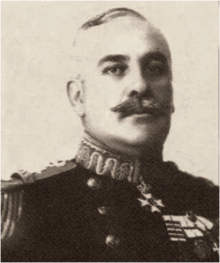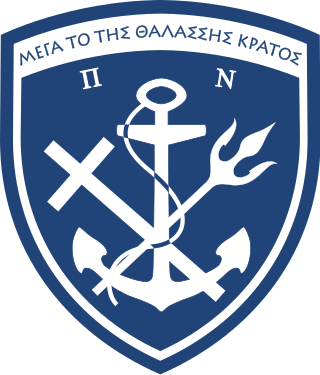
The Hellenic Navy is the naval force of Greece, part of the Hellenic Armed Forces. The modern Greek navy historically hails from the naval forces of various Aegean Islands, which fought in the Greek War of Independence. During the periods of monarchy it was known as the Royal Hellenic Navy.
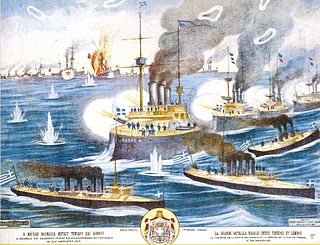
The Naval Battle of Lemnos, fought on 18 January [O.S. 5 January] 1913, was a naval battle during the First Balkan War, in which the Greeks defeated the second and last attempt of the Ottoman Empire to break the Greek naval blockade of the Dardanelles and reclaim supremacy over the Aegean Sea. This, the final naval battle of the First Balkan War, forced the Ottoman Navy to retreat to its base within the Dardanelles, from which it did not venture for the rest of the war, thus ensuring the dominion of the Aegean Sea and the Aegean islands by Greece.

Crossing the T or capping the T is a classic naval warfare tactic used from the late 19th to the mid-20th centuries in which a line of warships crosses in front of a line of enemy ships to allow the crossing line to bring all their guns to bear while it receives fire from only the forward guns of the enemy.
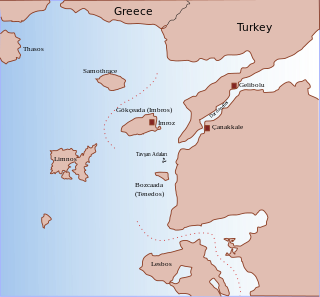
The Capture of Lemnos took place in October 1912 during the First Balkan War, serving as the opening action between Greek and Ottoman forces in the Aegean Sea. The strategic value of the island of Lemnos had been recognized by Greek naval planners for many years, as it lay at the entrance of the Dardanelles Strait and offered an excellent natural harbour in Mudros Bay. The island was occupied with little resistance from the small Ottoman garrison, which was taken prisoner. Mudros Bay was made into a forward naval base for the Greek navy, enabling it to blockade the Dardanelles and secure naval dominance in the Aegean. This obstructed the movement of Ottoman reinforcements to the front lines, and allowed the capture of the remaining Ottoman-held Aegean islands over the following months. Ceded to Greece in 1914, due to the subsequent outbreak of World War I, the island's status remained disputed, and its annexation to Greece was not confirmed until the Treaty of Lausanne in 1923.
The history of the Hellenic Navy begins with the birth of modern Greece, and due to the maritime nature of the country, this force has been the premier service of the Greek Armed Forces.

Pavlos Kountouriotis was a Greek admiral who served during the Balkan Wars, was regent of Greece, and the first president of the Second Hellenic Republic. In total he served four times as head of the Greek state, the most times in the history of the seat.

Georgios Averof is a modified Pisa-class armored cruiser built in Italy for the Royal Hellenic Navy in the first decade of the 20th century. The ship served as the Greek flagship during most of the first half of the century. Although popularly known as a battleship (θωρηκτό) in Greek, she is in fact an armored cruiser, the only ship of this type still in existence.
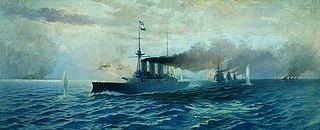
The Battle of Elli or the Battle of the Dardanelles took place near the mouth of the Dardanelles on 16 December [O.S. 3 December] 1912 as part of the First Balkan War between the fleets of the Kingdom of Greece and the Ottoman Empire. It was the largest sea battle of the Balkan Wars.

SMS Kurfürst Friedrich Wilhelm was one of the first ocean-going battleships of the German Kaiserliche Marine. The ship was named for Prince-elector Friedrich Wilhelm, 17th-century Duke of Prussia and Margrave of Brandenburg. She was the fourth pre-dreadnought of the Brandenburg class, along with her sister ships Brandenburg, Weissenburg, and Wörth. She was laid down in 1890 in the Imperial Dockyard in Wilhelmshaven, launched in 1891, and completed in 1893. The Brandenburg-class battleships carried six large-caliber guns in three twin turrets, as opposed to four guns in two turrets, as was the standard in other navies.
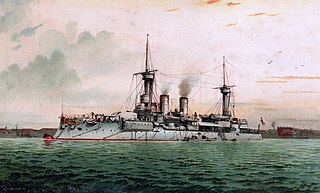
SMS Weissenburg was one of the first ocean-going battleships of the Imperial German Navy. She was the third pre-dreadnought of the Brandenburg class, which also included her sister ships Brandenburg, Wörth, and Kurfürst Friedrich Wilhelm. Weissenburg was laid down in 1890 in the AG Vulcan dockyard in Stettin, launched in 1891, and completed in 1894. The Brandenburg-class battleships were unique for their era in that they carried six large-caliber guns in three twin turrets, as opposed to four guns in two turrets, as was the standard in other navies.

Spetsai was a Greek ironclad battleship of the Hydra class that served in the Royal Hellenic Navy from 1890 until 1920. She was named after the Saronic Gulf island of Spetses, which played a key role in the war at sea during the Greek War of Independence. Spetsai she was ordered in 1885 in response to a crisis in the Balkans and Ottoman naval expansion. The ship was launched in 1889 and delivered to Greece by 1902. She was armed with a main battery of three 10.8 inches guns and five 5.9 inches guns, and had a top speed of 17 knots.

Hydra was an ironclad warship of the Greek Navy, named for Hydra, one of the Saronic Gulf islands which played a key role in the war at sea during the Greek War of Independence. The lead ship of her class of ironclads, she was ordered in 1885 in response to a crisis in the Balkans and Ottoman naval expansion. The ship was launched in 1889 and delivered to Greece by 1892. She was armed with a main battery of three 10.8 in (270 mm) guns and five 5.9 in (150 mm) guns, and had a top speed of 17 kn.

Psara was a steel-built ironclad warship named for one of the Aegean Sea islands that played a key role in the war at sea during the Greek War of Independence. The final vessel of the Hydra class, she was ordered in 1885 in response to a crisis in the Balkans and Ottoman naval expansion. The ship was launched in 1889 and delivered to Greece by 1902. She was armed with a main battery of three 10.8 in (270 mm) guns and five 5.9 in (150 mm) guns, and had a top speed of 17 kn.
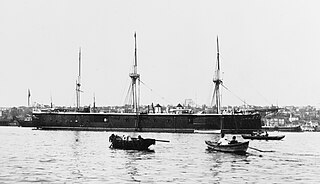
Mesudiye was a central-battery ironclad of the Ottoman Navy, one of the largest ships of that type ever built. She was built at the Thames Iron Works in Britain between 1871 and 1875. Mesudiye had one sister ship, though she was purchased by the Royal Navy and commissioned as HMS Superb. Her primary armament consisted of twelve 10-inch (250 mm) guns in a central armored battery.

Lonchi was a Thyella class destroyer that served in the Royal Hellenic Navy beginning in 1907. The ship, along with her three sister ships, was ordered from England in 1906 and was built in the Yarrow shipyard at Cubitt Town, London. Lonchi was 220 feet (67 m), displaced 352 metric tons, and was armed with two 18 in (46 cm) torpedo tubes, two 76 mm (3.0 in) guns, and two 57 mm (2.2 in) guns.

The Aetos class were four destroyers were originally constructed for the Argentine Navy as the San Luis class. In Greek they are known as the Thiria class, after the ships' names. They were purchased by the Royal Hellenic Navy in October 1912 when the Greek government expanded its navy after losing the Greco-Turkish War of 1897 and in anticipation of the Balkan Wars. In December 1916, during World War I, three of the destroyers were seized by France and served in the French Navy until 1918, all except Panthir. They were returned to Greece in 1918. In 1924–1925, they were extensively rebuilt and continued in service into World War II, where they fought with the Allies. Leon was sunk by German aircraft at Suda Bay, Crete. The other three destroyers survived the war and were used as station ships during the Greek Civil War. They were discarded in 1946.

Sofoklis Dousmanis was a Greek naval officer. Distinguished in the Balkan Wars, he became twice the chief of the Greek Navy General Staff, and occupied the post of Minister for Naval Affairs in 1935.

The Pisa class consisted of three armored cruisers built in Italy in the first decade of the 20th century. Two of these were for the Royal Italian Navy and the third was sold to the Royal Hellenic Navy and named Georgios Averof. This ship served as the Greek flagship for the bulk of her active career and participated in the Balkan Wars of 1912–1913, fighting in two battles against the Ottoman Navy. She played a minor role in World War II after escaping from Greece during the German invasion in early 1941. Influenced by communist agitators, her crew mutinied in 1944, but it was suppressed without any bloodshed. Georgios Averof returned to Greece after the German evacuation in late 1944 and became a museum ship in 1952. She is the only surviving armored cruiser in the world.

Alexandros Hatzikyriakos was a Greek Navy officer who rose to the rank of rear admiral. He played a major role in the establishment of the Second Hellenic Republic in 1924, and served thrice as Minister for Naval Affairs and two brief periods as Foreign Minister.
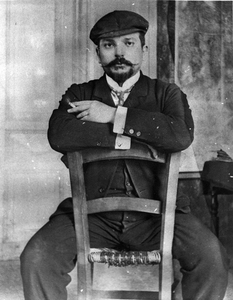
Georgios Kakoulidis was a Hellenic Navy officer, who served as Chief of the Hellenic Navy General Staff, and later became a politician.
